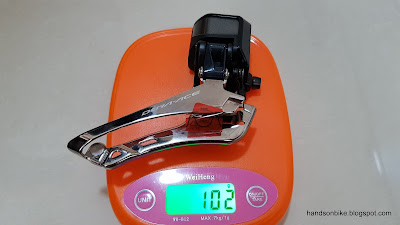Dahon Boardwalk Ultegra Di2 6770
Dahon Boardwalk Ultegra Di2 6870
Dahon MuEX Ultegra/XTR Di2
Wheelsport Fantasy Mini Velo Ultegra Di2 6870
Merida Scultura 5000 Ultegra Di2 6870
Avanti Inc 3 Alfine 11 Di2
Once you have tried electronic shifting, it is hard to go back to mechanical shifting, as the shifting force is so light, and the buttons are easy to activate with just one finger.
The Canyon Endurace comes with the Ultegra Di2 6870 groupset, which is a great Di2 groupset. However, my intention all along was to upgrade the components to the latest Dura-Ace R9170 when they became available. Let's take a closer look at the Di2 rear derailleur and front derailleur to see how different it is from the previous generation.
For the rear derailleur, the main difference is the new construction design. From the double servo construction of previous road rear derailleurs, the latest R9150 Di2 rear derailleur is now using the Shadow construction of MTB rear derailleurs. This lowers the profile of the rear derailleur, reducing the amount which the derailleur sticks out from the side of the bike. You can see the design of the previous generations here.
Shadow construction used for the new Dura-Ace Di2 R9150 rear derailleur. Servo motor is located at the rear and looks really small.
Weighs only 197 grams, including the motor! Lightweight materials are used throughout the whole component.
Extra link to shift the pivot of the derailleur rearwards, allowing for a Shadow construction.
E-tube port for connecting the Di2 wire is hidden behind, for a minimal profile.
B-tension screw and the two limit screws are located just beside the motor, and are adjusted using Allen keys and not screwdrivers.
Very industrial design with the cover of the motor following the shape of the internal parts of the motor and gearbox.
Tall toothed guide pulley to improve shifting speed and accuracy
Short toothed tension pulley to minimize running noise when cross-chained.
Carbon inner and outer plates minimize the weight but increases the cost considerably.
Bottom side of the derailleur. Rivets are capped with a black sticker for a nicer appearance.
Upper side of the derailleur. The saver unit has been moved from the bottom (previous generation) to the top, probably due to the change to Shadow design. This is the position during normal operation.
If the derailleur receives an impact from the side, the saver unit will give way and disengage from the motor, as shown here. This prevents damage to the motor unit.
With the change of construction, this rear derailleur looks and operates quite differently from the previous generation of Di2 rear derailleur. More findings will be shared after installation to the bike.
As for the front derailleur, it remains largely unchanged from the previous generation, at least in terms of external appearance.
Dura-Ace Di2 R9150 front derailleur. The little black plastic piece shown at the side is the cap for covering the Di2 wire.
The Di2 wire connection is now facing the rear of the bike.
To use the cap, first insert the Di2 wire into the cap, and use it to insert and remove the Di2 wire from the front derailleur. This cap also protects the port from water and dirt.
Front derailleur weighs 102 grams, not much heavier than a mechanical front derailleur.
The main appearance surface of the front derailleur
Inside surface of the front derailleur
Rear end of the front derailleur, where the rivets can be seen
Front end where the black clamp bolt can be seen
The grey inner link seems to be made of titanium, as it is not attracted to a magnet and does not look like aluminium.
The biggest surprise for me is how lightweight the Dura-Ace Di2 front and rear derailleurs are. With a combined weight of only 300 grams, they are super lightweight, and it includes the motor!





















Being in the land of technology, have you seen any carbon fiber folding frames for v brakes? 451 or 406 wheels. I would love it if I could just get the frame. I already have a control tech front fork and 33.9 seat post. Currently have them on a dahon vitesse d20, that I put old school DA 7970 di2 on. I've also built a Mu P10 with a bionx motor (scary fast, took out the limiter, and di2, but 38 lbs with battery), and a Tern D20 with 7970 di2 and lots of kcnc and Dura Ace goodies) Maybe you even have one in your goodie box waiting to get built? Thanks for your advice ! Don
ReplyDeleteJava has a carbon frame folding bike, for 20 inch wheels.
DeleteI found that Java frame on aliexpress and am looking on line for people that may have purchased it and had any problems. Do you have any associates or friends that may have purchased it that have had any problems? like cracking frames? Or have purchased the frame and "loved it"? I found a "Silverock" frame that the company sells without the Java decals. Thanks for your advice. BTW: That Canyon project looks really cool, it looks like a weight weenie ! Looks really expensive..
ReplyDeleteI have not had any problems with the Java Freccia frame, except for the insufficient brake caliper reach.
DeleteI don't know anyone who also has this frame, it seems to be quite rare to find in Singapore.
It is a nice lightweight mini velo frame which I like. The ideal frameset to make a lightweight setup.
how light did you get it down to?
ReplyDeleteThe lowest weight for my setup was 6.3kg without pedals.
Deletehttp://handsonbike.blogspot.sg/2017/06/java-freccia-carbon-mini-velo-part-7.html